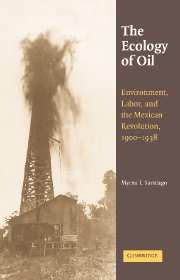Book contents
- Frontmatter
- Dedication
- Contents
- List of Maps, Figures, Tables, and Appendices
- Acknowledgments
- Introduction
- PART ONE THE HUASTECA BEFORE OIL
- 1 “Paradise” and “Progress”: The Huasteca in the Nineteenth Century
- PART TWO THE ECOLOGY OF OIL
- PART THREE CHALLENGING THE ECOLOGY OF OIL
- Conclusion
- Epilogue
- Appendices
- A Note on the Sources
- Archives Consulted
- Selected Bibliography
- Index
1 - “Paradise” and “Progress”: The Huasteca in the Nineteenth Century
from PART ONE - THE HUASTECA BEFORE OIL
Published online by Cambridge University Press: 05 March 2015
- Frontmatter
- Dedication
- Contents
- List of Maps, Figures, Tables, and Appendices
- Acknowledgments
- Introduction
- PART ONE THE HUASTECA BEFORE OIL
- 1 “Paradise” and “Progress”: The Huasteca in the Nineteenth Century
- PART TWO THE ECOLOGY OF OIL
- PART THREE CHALLENGING THE ECOLOGY OF OIL
- Conclusion
- Epilogue
- Appendices
- A Note on the Sources
- Archives Consulted
- Selected Bibliography
- Index
Summary
A great variety of other trees are met with here, of magnificent size and splendid foliage, waving their brilliant branches in the breeze, and presenting strong inducements to the traveler continually to pause in wonder and admiration. In good sooth, it may be said that “man is the only thing that dwindles here.”
B. M. Norman, 1845In 1921 the California oil magnate Edward L. Doheny delivered a speech before his colleagues at the American Petroleum Institute. In addition to reporting that his Mexican Petroleum Company made over 100 million dollars in profits, he recalled his first visit to northern Veracruz in 1900.As the train descended from the mountains of the Sierra Madre Oriental, even an unsentimental businessman like him could not help but be moved by the landscape. Before his eyes lay
beautiful and awe-inspiring scenery… down past rivers of clear blue-green water; past the [water]falls… where the leap of the water to where it falls in a mass of white foam is over 270 feet; … and for a short space one sees only the skies before plunging into a forest so dense that it is hidden almost completely as it winds its way through the jungle to the Pánuco [River], thence to the sea; jungle-covered country which extends clear to the harbor of Tampico.
The “jungle” Doheny remembered was the northernmost end of the Mexican tropics, an area known as the Huasteca. Besides hiding the forest and, indeed, because of the forest itself, the place “hid” a complex natural history and a turbulent political past the oilman could hardly imagine. As soon as Mexico had won its independence from Spain in the early nineteenth century, different actors – indigenous peoples, Mexican elites, foreigners, and nature itself – had become entangled in fierce struggles over the ecology of the area. Although the forest still stood outside Doheny's private railroad car in 1900, the conflict over its future was far from resolved. Unknowingly, Doheny was also entering into a history of ecological war.
The Huasteca
The state of Veracruz rests like a half moon on the shores of the Gulf of Mexico. Scholars divide the state into three geographical slices: north, center, and south.
- Type
- Chapter
- Information
- The Ecology of OilEnvironment, Labor, and the Mexican Revolution, 1900–1938, pp. 15 - 58Publisher: Cambridge University PressPrint publication year: 2006



